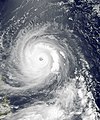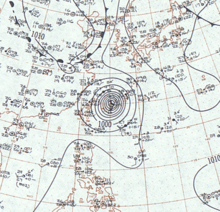Portal:Tropical cyclones
The Tropical Cyclones Portal

A tropical cyclone is a storm system characterized by a large low-pressure center, a closed low-level circulation and a spiral arrangement of numerous thunderstorms that produce strong winds and heavy rainfall. Tropical cyclones feed on the heat released when moist air rises, resulting in condensation of water vapor contained in the moist air. They are fueled by a different heat mechanism than other cyclonic windstorms such as Nor'easters, European windstorms and polar lows, leading to their classification as "warm core" storm systems. Most tropical cyclones originate in the doldrums, approximately ten degrees from the Equator.
The term "tropical" refers to both the geographic origin of these systems, which form almost exclusively in tropical regions of the globe, as well as to their formation in maritime tropical air masses. The term "cyclone" refers to such storms' cyclonic nature, with anticlockwise rotation in the Northern Hemisphere and clockwise rotation in the Southern Hemisphere. Depending on its location and intensity, a tropical cyclone may be referred to by names such as "hurricane", "typhoon", "tropical storm", "cyclonic storm", "tropical depression" or simply "cyclone".
Types of cyclone: 1. A "Typhoon" is a tropical cyclone located in the North-west Pacific Ocean which has the most cyclonic activity and storms occur year-round. 2. A "Hurricane" is also a tropical cyclone located at the North Atlantic Ocean or North-east Pacific Ocean which have an average storm activity and storms typically form between May 15 and November 30. 3. A "Cyclone" is a tropical cyclone that occurs in the South Pacific and Indian Oceans.
Selected named cyclone -
Typhoon Sarah, known as the Miyakojima Typhoon in Japan, was a destructive typhoon, and among the deadliest on record in the western Pacific Ocean, killing around 2,000 people. It formed during the peak of the busy 1959 Pacific typhoon season near Guam, and moved generally to the west-northwest. Continued observations from the hurricane hunters allowed the Joint Typhoon Warning Center (JTWC) to track Sarah from its origins to its peak as a powerful typhoon, with maximum sustained winds estimated at 305 km/h (190 mph) on September 15. Shortly thereafter, the typhoon struck the small Japanese island of Miyako-jima, where the barometric pressure fell to 908.1 mbar (26.82 inHg), the second-lowest on record for the country. Sarah turned to the north and northeast, weakening from its peak intensity. On September 17, the typhoon made landfall just west of Busan, South Korea with winds of 185 km/h (115 mph), the nation's strongest landfall at the time and only to be surpassed by Typhoon Maemi in 2003. Sarah later became extratropical over the Japanese island of Hokkaido on September 18, although the remnants persisted for several days, crossing into the Russian Far East and later dissipating on September 23.
On Miyako-jima, Sarah damaged all of the crops and destroyed about 6,000 houses. Damage was estimated at $2 million, and there were seven deaths. The damage prompted the Japan Meteorological Agency to give Sarah the special name of the "Miyakojima Typhoon". However, the effects were worst in South Korea, and Sarah was described as the worst typhoon there in 50 years. Wind gusts there peaked at 169 km/h (105 mph), the highest at the time in the country. High winds and waves heavily damaged the port of Busan. Nationwide, the storm destroyed over 14,000 homes and left 782,126 people homeless, causing over $100 million in damage. At least 669 people were killed in South Korea, and an additional 1,200 fishermen were lost offshore the country. In Japan, widespread flooding killed 47 people and destroyed 16,632 homes. (Full article...)Selected article -

Selected image -

Selected season -

The 2003 Atlantic hurricane season was a very active season with tropical cyclogenesis occurring before and after the official bounds of the season—the first such occurrence since the 1970 season. The season produced 21 tropical cyclones, of which 16 developed into named storms; seven of those attained hurricane status, of which three reached major hurricane status. The strongest hurricane of the season was Hurricane Isabel, which reached Category 5 status on the Saffir–Simpson hurricane scale northeast of the Lesser Antilles; Isabel later struck North Carolina as a Category 2 hurricane, causing $3.6 billion in damage (2003 USD) and a total of 51 deaths across the Mid-Atlantic region of the United States.
Although the bounds of the season are typically from June 1 to November 30, the season began early with the formation of Subtropical Storm Ana on April 20, and it ended relatively late on December 11 with the dissipation of Tropical Storm Peter. In early September, Hurricane Fabian struck Bermuda as a Category 3 hurricane, where it was the worst hurricane since 1926; on the island it caused four deaths and $300 million in damage (2003 USD). Hurricane Juan caused considerable destruction to Nova Scotia, particularly Halifax, as a Category 2 hurricane, the first hurricane of significant strength to hit the province since 1893. Additionally, Hurricanes Claudette and Erika struck Texas and Mexico, respectively, as minimal hurricanes. In December, Tropical Storm Odette struck the Dominican Republic, and Tropical Storm Peter formed in the eastern portion of the basin. (Full article...)Related portals
Currently active tropical cyclones

Italicized basins are unofficial.
- North Atlantic (2024)
- No active systems
- East and Central Pacific (2024)
- No active systems
- West Pacific (2024)
- No active systems
- North Indian Ocean (2024)
- No active systems
- Mediterranean (2023–24)
- No active systems
- South-West Indian Ocean (2023–24)
- No active systems
- Australian region (2023–24)
- No active systems
- South Pacific (2023–24)
- No active systems
- South Atlantic (2023–24)
- No active systems
Last updated: 21:54, 8 May 2024 (UTC)
Tropical cyclone anniversaries

May 10
- 1972 - Cyclone Hannah impacts Papua New Guinea as a weak cyclone.
- 2002 - The 2002 Oman cyclone made landfall in Oman, bringing up to 250 mm (9.8 in) of rain.
- 2015 - Typhoon Noul (pictured) made landfall over in Santa Ana, Cagayan at Category 5 typhoon intensity.

May 11
- 1965 - The first of two cyclones to impact Bangladesh in 1965 made landfall on the country. These two storms collectively killed 47,000 people.
- 2019 - Cyclone Lili (pictured) made landfall over East Timor before dissipating the same day. The storm caused significant flooding over the island.

- May 12, 1991 - Typhoon Walt (pictured) reached its peak intensity to the east of the Philippines with 260 km/h (160 mph) winds. Cyclone Lisa developed in the Southern Hemisphere concurrently with Walt.
Did you know…




- …that the Joint Typhoon Warning Center considers that Typhoon Vera (pictured) of 1986 is actually two distinct systems, formed from two separated low-level circulations?
- …that Hurricane Agatha (pictured) was the strongest Pacific hurricane to make landfall in Mexico in May since records began in 1949?
- …that Cyclone Raquel (track pictured) travelled between the Australian and South Pacific basins between the 2014–15 and 2015–16 seasons, spanning both seasons in both basins?
- …that Cyclone Amphan (pictured) in 2020 was the first storm to be classified as a Super Cyclonic Storm in the Bay of Bengal since 1999?
General images -

The following is a list of tropical cyclones that affected the U.S. state of Delaware. Since reliable records began, no tropical cyclone has struck the state while maintaining hurricane intensity, and only two storms since 1851 caused hurricane-force winds in the state.
- October 21, 1749 – A hurricane impacted the Mid-Atlantic, and impacts were observed in Delaware, but it's unclear at what strength the storm was when it impacted the state.
- Fall, 1783 – Nine large ships crash near Cape Henlopen during a gale, killing several people.
- September 2, 1785 – A hurricane causes 181 deaths in the state. Whether or not it made landfall is unknown.
- September 3–5, 1815 – A tropical storm passes over extreme southeastern Delaware. Effects, if any, are unknown.
- September 3, 1821 – The eye of the Norfolk and Long Island Hurricane moves directly over Cape Henlopen for 30 minutes.
- August 17, 1830 – A hurricane that passes to the east of the state capsizes three ships along the Delaware capes. (Full article...)
Topics
Subcategories
Related WikiProjects
WikiProject Tropical cyclones is the central point of coordination for Wikipedia's coverage of tropical cyclones. Feel free to help!
WikiProject Weather is the main center point of coordination for Wikipedia's coverage of meteorology in general, and the parent project of WikiProject Tropical cyclones. Three other branches of WikiProject Weather in particular share significant overlaps with WikiProject Tropical cyclones:
- The Non-tropical storms task force coordinates most of Wikipedia's coverage on extratropical cyclones, which tropical cyclones often transition into near the end of their lifespan.
- The Floods task force takes on the scope of flooding events all over the world, with rainfall from tropical cyclones a significant factor in many of them.
- WikiProject Severe weather documents the effects of extreme weather such as tornadoes, which landfalling tropical cyclones can produce.
Things you can do
 |
Here are some tasks awaiting attention:
|
Wikimedia
The following Wikimedia Foundation sister projects provide more on this subject:
-
Commons
Free media repository -
Wikibooks
Free textbooks and manuals -
Wikidata
Free knowledge base -
Wikinews
Free-content news -
Wikiquote
Collection of quotations -
Wikisource
Free-content library -
Wikiversity
Free learning tools -
Wikivoyage
Free travel guide -
Wiktionary
Dictionary and thesaurus























































